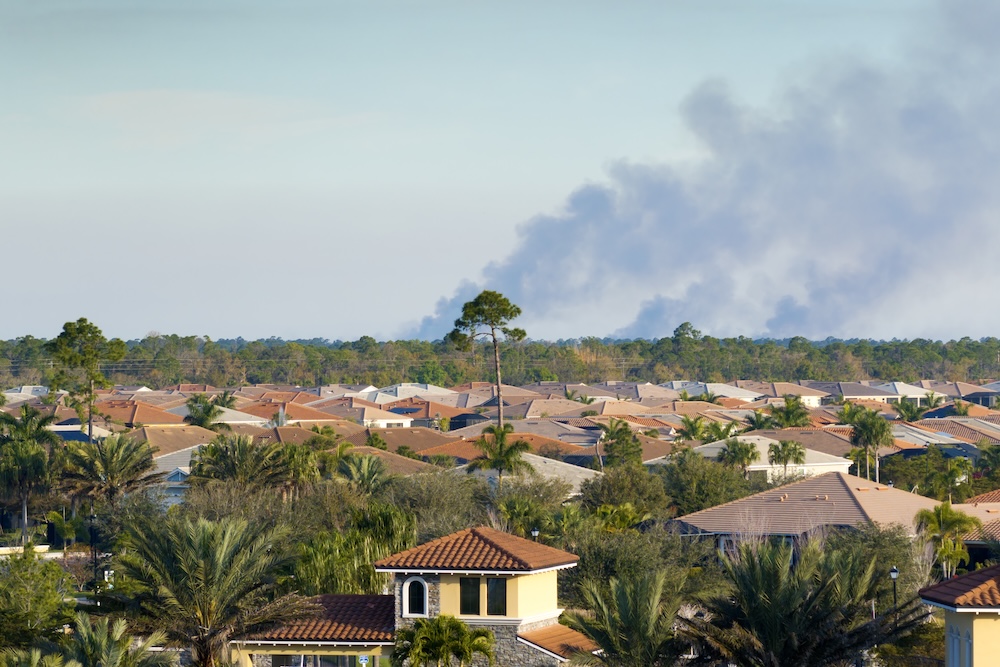Wildfires are no longer rare disasters. They’re part of a new normal — one shaped by climate change, land mismanagement, and human expansion into fire-prone areas. As these blazes become more intense and unpredictable, preparing your home and community isn’t optional. It’s essential.
From home upgrades to neighborhood-wide strategies, here’s how to fire-proof the future — one smart step at a time.
Why We Need Fire-Resilient Homes
Climate-fueled wildfires are bigger, faster, and more frequent than ever. Across North America, fire seasons now stretch from spring into winter. In some regions, wildfires threaten more homes than floods or hurricanes.
But here’s the good news: more than 90% of homes that burn in wildfires ignite from embers, not direct flames. That means many homes can be saved — not by luck, but by preparation.
Fire-resilient design doesn’t just protect property. It buys time for evacuation, reduces firefighter risk, and helps communities recover faster. In short, it saves lives.
What Makes a Home Wildfire-Ready?
Building or upgrading a fire-resistant home involves three major areas: materials, design, and defensible space.
Use Fire-Resistant Materials
Not all construction materials behave the same under fire. Choosing the right ones can make the difference between survival and total loss.
- Roofing: Use Class A fire-rated roofing materials such as metal, clay tile, or asphalt composite shingles.
- Siding: Fiber cement, stucco, and treated wood are more fire-resistant than vinyl or untreated wood.
- Windows: Double-paned or tempered glass is far less likely to break under heat, which can prevent embers from entering.
- Vents: Cover all attic and crawl space vents with fine, corrosion-resistant mesh (1/8 inch or finer) to block embers.
- Decks: Build with ignition-resistant materials and keep decks clear of debris.
Create Defensible Space
Defensible space is the buffer zone between your home and flammable vegetation. It slows the spread of fire and gives firefighters room to operate.
Divide your landscape into three zones:
Zone 1: 0–5 feet
- Keep this area clear of anything flammable (plants, mulch, furniture).
- Use gravel or stone instead of bark mulch.
- Store firewood and propane tanks at least 30 feet from the home.
Zone 2: 5–30 feet
- Trim trees so branches are at least 10 feet from your roof.
- Prune shrubs and remove dead vegetation regularly.
- Space trees and plants to reduce fuel continuity.
Zone 3: 30–100 feet
- Thin dense trees and underbrush.
- Maintain healthy native vegetation.
- Use fire-resistant plants whenever possible.
Seal Gaps and Eliminate Ember Traps
Embers can travel miles ahead of a fire. They land on rooftops, get sucked into vents, and gather in corners. Sealing gaps, cleaning gutters, and inspecting roofs are small actions that make a big difference.
Retrofit or Rebuild?
Retrofitting an existing home can dramatically improve its wildfire resilience. In fact, studies from California show that homes built or retrofitted to modern fire standards are far more likely to survive.
Key retrofit options include:
- Replacing old roofs and siding with fire-rated materials
- Installing ember-proof vents
- Upgrading windows and screens
- Removing vegetation around the home
If you’re building from scratch in a high-risk area, consider the Wildland Urban Interface building codes. These guidelines are designed specifically for homes in fire-prone regions.
Community-Level Fire Readiness
Fire resilience isn’t just about individual homes. Neighborhoods and communities that work together are much more likely to survive.
Become a Firewise Community
The Firewise USA® program, supported by the National Fire Protection Association (NFPA), helps communities reduce wildfire risk through collective action. Neighborhoods that participate:
- Create community wildfire protection plans
- Conduct annual cleanup and maintenance
- Educate residents about fire safety
- Often qualify for insurance discounts
Invest in Shared Defensible Space
Public land, parks, trails, and roadways can become fire corridors if left unmanaged. Communities should:
- Collaborate with local fire departments and land managers
- Maintain buffer zones between homes and open spaces
- Remove dead trees and underbrush in common areas
Prepare for Evacuation and Power Outages
Wildfires often come with little warning. Every community should have:
- Evacuation routes and signage
- Emergency text alert systems
- Community-wide drills and education
- Backup power for critical facilities
Fire Insurance and Home Value
Insurers are increasingly factoring fire risk into premiums — and in some cases, refusing coverage altogether in high-risk zones. Homes that are fire-hardened, especially in Firewise communities, may be eligible for:
- Lower premiums
- More policy options
- Faster rebuilding support after disaster
Investing in fire resilience isn’t just about safety. It also protects home equity and resale value.
Building with the Future in Mind
Fire-proofing should be part of a larger climate adaptation strategy. This includes:
- Rainwater collection: For irrigation and emergency use
- Off-grid energy: Solar systems with battery storage to power fans and filters during outages
- Non-combustible fencing: Use metal, stone, or other materials that won’t carry fire to your house
- Smart landscaping: Choose plants that retain moisture, resist ignition, and are spaced properly
A home is more than walls and a roof — it’s part of a living landscape. Fire-smart design means building in harmony with that reality.
Final Thoughts: Protecting What Matters Most
Wildfires are a growing part of our climate-changed world, but devastation is not inevitable. With the right choices, we can reduce risk, protect families, and create communities that are safer, stronger, and more sustainable.
Preparing for wildfire is not alarmist — it’s wise. Because when fire comes, it won’t wait for you to be ready.
Be the reason your neighborhood still stands.









Reader Interactions